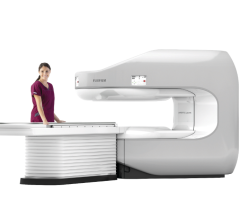
For the first time at the RSNA meeting, vendors of interventional products will have a dedicated area in which to display and demonstrate their products. This IR zone, as it is being called, is supposed to make it easier for interventional radiologists to work with relevant companies.
John A. Kaufman, M.D., chair of the Department of Interventional Radiology and director of the Dotter Interventional Institute at the Oregon Health and Science University in Portland, discussed this change in exhibitor space and the rising profile of interventional radiology in medical practice in the ITN PODCAST Hear and Now: Intervention Rising.
“For many years, I think interventional radiologists have had a sense that there is not a lot for me here, particularly on the exhibit floor,” Kaufman said. “The programming has really developed beautifully. (There’s been a) big emphasis on oncology and other aspects of interventional radiology. But the floor for the interventionalist has not been as interesting.”
That will change at RSNA 2018 and the change will be a positive one for interventional radiology. “It supports the whole concept that we have been trying to promote of this really tight relationship,” he said between mainstream diagnostic radiology and interventional radiology, a change exemplified by the Society’s dedication of a part of the exhibit floor to interventional products. Recent changes in certification by the American Board of Radiology (ABR) support this burgeoning relationship.
Notably, the ABR has recently created a new certification, called Interventional Radiology/Diagnostic Radiology (IR/DR). With its creation, IR/DR joins just three other specialties certified by the Board – Diagnostic Radiology, Radiation Oncology and Medical Physics. The resulting new residency options available to medical students have created “tremendous interest” in interventional radiology.
“Very large numbers of people are applying for this,” Kaufman said. Also rising, he said, is the quality of applicants: “Not only are the numbers way up, but we feel that the people coming in are phenomenal.”
Kaufman described the current situation as the start of a new era, one exemplified by this new certification, which combines both diagnostic radiology and interventional radiology.
“We feel that by having the IR/DR certificate the interventional radiology residency — which is really an interventional and diagnostic radiology residency — has positioned the house of radiology to be well-suited to provide (minimally invasive) care,” he said, noting optimism about the future of this newly certified specialty. “I’m really hoping this leads not only to more individuals and people performing at a high level in clinical practice, but also really fleshing out the research side of the specialty and developing a lot of the fundamental knowledge base that we think is important.”
Listen to the PODCAST Hear and Now: Intervention Rising
Listen to the first PODCAST PET Ready To Expand Into Sports Medicine And Beyond
For additional information, read the article PET Ready To Expand Into Sports Medicine And Beyond.



 July 30, 2024
July 30, 2024 








